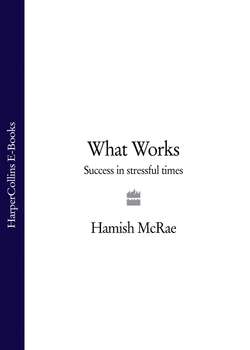Читать книгу What Works: Success in Stressful Times - Hamish McRae - Страница 7
3. THE POWER OF GOOD IDEAS – AND THE VARIETY OF PLACES THEY COME FROM
ОглавлениеThe world is at one of those inflection points that historians will look back upon with awe. Economic power is rebalancing away from Europe and, to some extent, North America and principally towards Asia. It is the biggest shift of power since the Industrial Revolution, which enabled Europe and then North America to leap ahead of the more populous Asia. In 1820, by far the largest economies in the world were China and India. Fast forward and, within a generation, China seems set to overtake the USA as the largest-it probably overtook Japan to become the second biggest some time in 2009-while India is likely to move into the number three slot. Other countries, including Brazil and Russia, will not be far behind. Most people in the West are vaguely aware of the rising power of the so-called emerging economies, particularly of China, but have hardly begun to think through the consequences of this.
This shift is not just about economics; it is also about ideas. We are moving from a period when most of the ideas that have driven the world economy have come from the West, to one where many will come from the East-and the rest of the emerging world. For the moment the mixed-economy model of Europe, Japan and, in a slightly different form, the USA remains the one that is being adopted in the rest of the world. On the surface it looks as though a form of Western capitalism is being recreated in China and to some extent in India. In the summer of 2009 the Shanghai Stock Exchange became the second largest in the world after New York, in the sense that the value of the companies traded on it was second only to those traded on Wall Street. But that was in part because Chinese banks had adopted a different set of business practices to those of their US counterparts and it was in part, too, because the Chinese government had followed a totally different fiscal strategy from that of the USA or most European governments.
China and India, together with many other emerging nations, came out of the economic downturn in far better shape than the USA, Europe or Japan. On the face of it, the ideas of the emerging world look rather more effective than those of the West.
The purpose of this book is not to look at the future shape of the world, and the way it is changing, from a macro-economic perspective. That is what I spend much of my day job doing, and it was also the approach of The World in 2020. My aim here, in starting from a series of stories, is to illustrate how there are great ideas and innovations in Western societies but also similarly great ideas and innovations in the emerging world.
That surely is the future. Good ideas will increasingly come from anywhere and everywhere. We need to learn from each other. You cannot, of course, lift one way of doing things, transplant it to the other side of the earth and expect it to flourish. You could not create an Edinburgh Festival in China any more than you could make New York as safe as Tokyo. You could not build as good a university as Harvard even in Bangalore, or at least it would take several generations to do so. And you could not transport Hong Kong’s lean government to the welfare states of Western Europe, though there are some things we could learn from that. Indeed I hope we can all learn a bit from each of these stories, and try to apply some elements of their success. I’ve picked out three key lessons (bulleted) in each example and highlighted some further lessons in the conclusion.
We can also learn from the weaknesses. While every single example here is one of something that has been successful, every single story in some way encompasses threats that must be overcome or flaws that must be fixed. I have tried to highlight these for this is what makes the stories real. One of the great puzzles is the way in which clever, thoughtful and decent people can get things wrong.
What interests me most about these examples is partly the extent to which the baton of success can be passed on from one generation to another but it is also the extent to which an entity has the capacity to correct its course when the winds change.
As noted at the beginning of this introduction, the winds have changed sharply during the writing of this book. That makes for a much more interesting world, a much more challenging one, and one where we should dump ideological explanations and responses and simply build on ‘what works’. I hope you will enjoy the journey.
